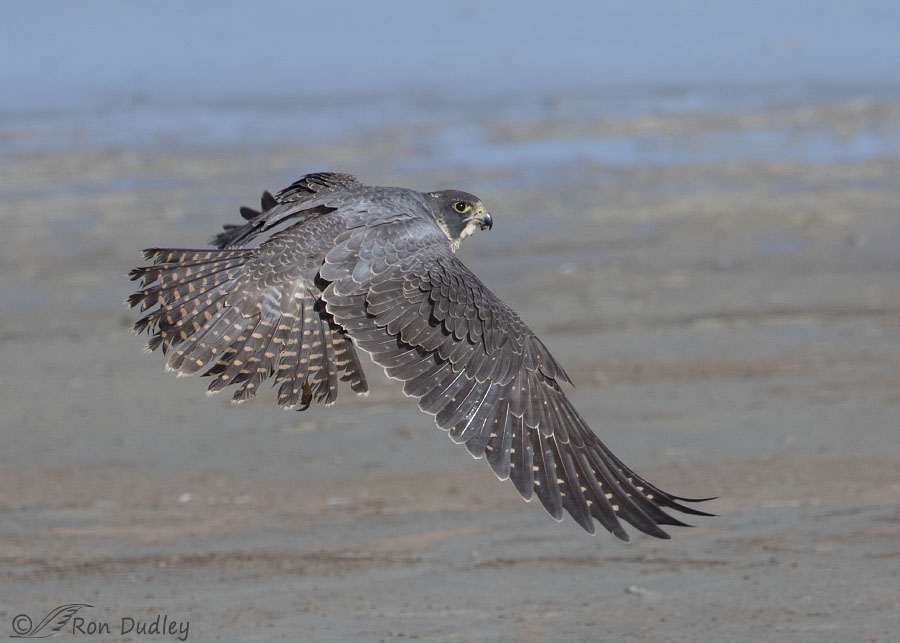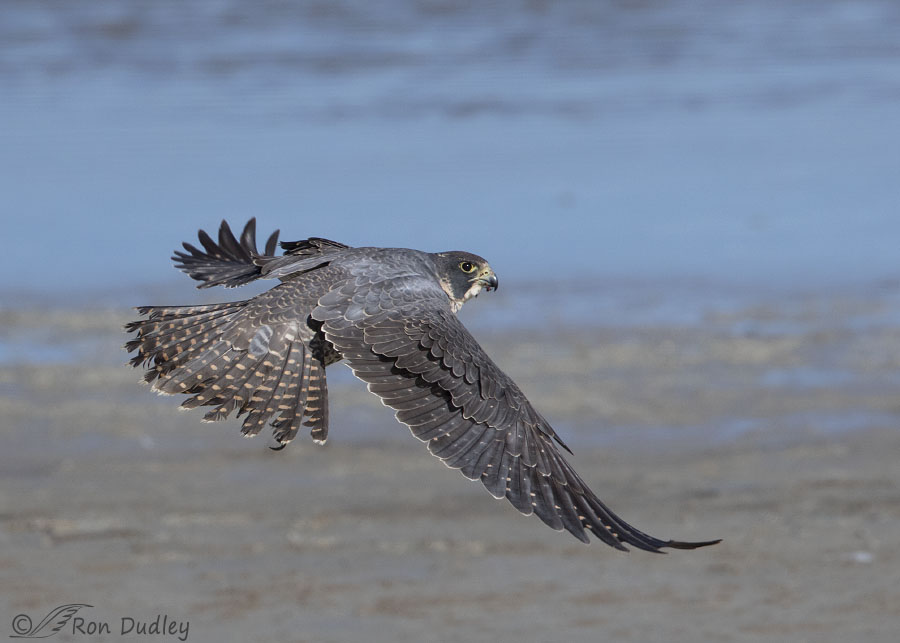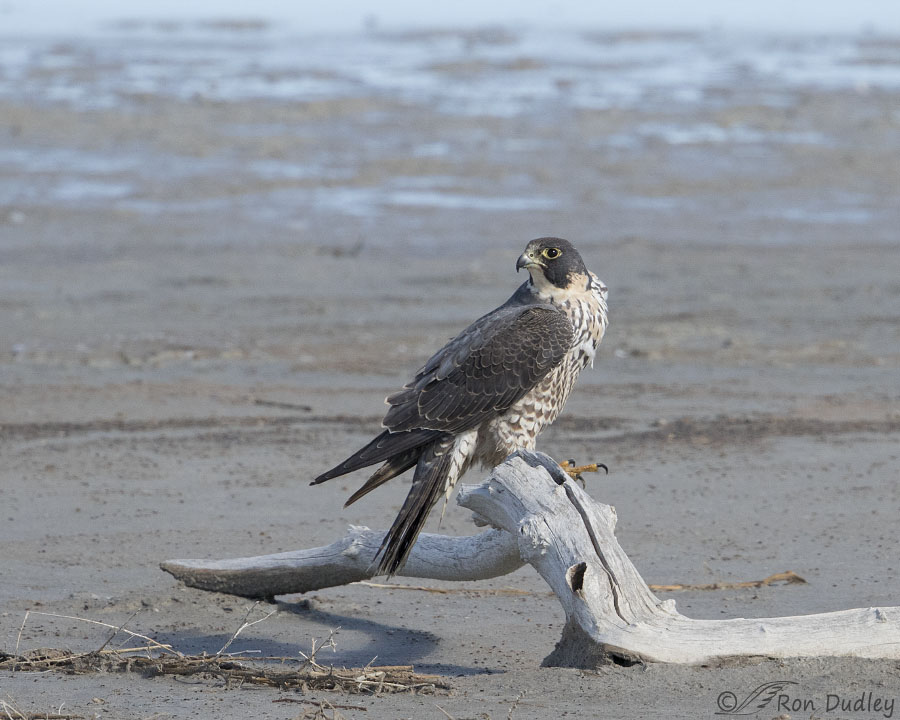I believe it to be a juvenile transitioning into adult plumage.

1/4000, f/6.3, ISO 400, Canon 7D Mark II, Canon EF 500mm f/4L IS II USM + EF 1.4 III Extender, not baited, set up or called in
I photographed this bird two years ago today along the causeway to Antelope Island. It had recently taken off and was flying in the direction of the nearby Great Salt Lake whose muddy shoreline can be seen in the upper background. Even though the bird is headed away from me I like the fanned tail, the plumage detail on the right wing and the look back at me from the falcon.

1/4000, f/6.3, ISO 400, Canon 7D Mark II, Canon EF 500mm f/4L IS II USM + EF 1.4 III Extender, not baited, set up or called in
Four clicks later I got an almost identical flight pose from the bird but I like this one slightly better because we can see a little more of the left wing and there’s more blue water in the upper background.
But one of the most interesting things about these photos is the blue/gray feathers along the back, the base of the wings and even on a single uppertail covert. All three of these shots are new to my blog but when I posted other similar photos of this falcon two years ago there was a lot of discussion about the molt stage of the bird. That discussion centered around whether or not those blue/gray feathers were discolored juvenile feathers or recently replaced adult feathers or the color difference was simply due to individual variation. Occasionally peregrines are known to have a gray/blue “bloom” on their feathers from powder down which can “discolor” feathers.
Some folks had pretty strong opinions about this bird and the discussion nearly became heated when one person made an inappropriate and unnecessary accusation so I turned the commenting option off for that post. That’s a Pandora’s box I’d prefer to avoid opening again but for those interested in the intricacies of raptor molt it’s still a fascinating discussion and it can be seen here.

1/2500, f/6.3, ISO 800, Canon 7D Mark II, Canon EF 500mm f/4L IS II USM + EF 1.4 III Extender, not baited, set up or called in
I was able to get a few photos of the falcon on an old driftwood perch but I wasn’t particularly close to the bird and some of the whites on the perch are pretty bright and don’t show much detail.
Ron


Beautiful pictures Ron. I too enjoy the picture of the bird on the driftwood.
Thank you, Jean. So do I.
Love the curve of the wing and the fanned tail. And in the second shot the ‘curl’ of the feathers.
Oh to be able to fly.
And yes, that look is some way down the stink-eye path. Which I do when faced with a camera too.
“Which I do when faced with a camera too”
Ha, wish I could be the one with the camera capturing your stink-eye, EC. I’d make you famous!
Infamous. And your camera would fail.
My face tends to crack lenses — like Ella’s voice!
Beautiful bird, especially like the shot on the (dry-ki) indian word for driftwood, just because my fingers get antsy to carve when I see that kind of pose. The other two shots make me tired because of all the detail I would have to carve and paint, just kidding! Gorgeous bird!
Dick, given as much carving as you’ve done over the years you’re lucky to still have all your fingers to get antsy! Thanks.
Thanks.
Your right – but if the truth be known I’m real careful with knives and chisels. But I did lose the end of one finger because I tried a STUPID MOVE, by trying to move an unmoving fan belt while a boat engine was on. The doc wanted to take my finger down to the first knuckle, but I said NO! Today you wouldn’t know it except for the shortened fingernail.
Speaking of stupid moves my brother-in-law had a doozy some years ago. He reached down to clear the chute of a clogged lawnmower and lost the last joint of one of his fingers. I always told him it ruined his modus operandi because that was his nose-pickin’ finger…
Now that is a typical family response. And ouch. Perhaps there are some positives to being a wimp around machinery.
At least he has a “spare” and didn’t hurt his “bird” finger.
Beautiful bird, lovely bluish colors no matter the hows and whys. I hope you are out catching the short sucker hole this morning.
April, I’ve decided that weather radar is WORSE THAN USELESS! The radar looked absolutely clear this morning so I headed north in the dark. By the time it got light enough to see – sure enough, it was completely socked in up there with dense clouds that didn’t show up on rader. And it stayed that way all morning. I wasn’t a happy camper…
Despite that this young lady needs a good preen on her tail, what a beauty! I keep coming back to that question, how do you DO that?
To me, the flight shots are outstanding showing all the covert feathers in action during flight! I also love it that she’s giving you a mildly dirty look as she makes her escape. It’s not stink eye, but it’s along that path.
“It’s not stink eye, but it’s along that path”
Yeah, I don’t think she liked that big lens pointing her way, Laura.
Coloring of the peregrines here somewhat different – a lot of bright yellow around the eye, on the legs and feet. Different genes, I suppose. A few months ago, watched a gang of turkey vultures and crows drive a peregrine off her kill on a beach – the scoter’s feather were flying all around, the vultures and crows were all over the carcass, and the peregrine was on a driftwood log some yards away looking glum. I wonder if they have no ability to fight for their kill…I’m still curious about it.
“I wonder if they have no ability to fight for their kill…I’m still curious about it”
That might be a question for a falconer, Martha. Maybe one will chime in here.
Hi Martha. A peregrine hunts in the air, GENERALLY making the kill in the bottom part of a J-shaped dive. They’re not real powerful from the ground so they would have to defer to vultures and crows on a kill. Now if it were a golden eagle or a redtail, the vultures/crows would know better than to challenge them on a kill. They might harass the eagle or buteo, but the chances of getting nailed themselves is reasonably high. They MIGHT get away with it, but the danger is high. It’s just about the differing flight/hunting strategies/abilities. There’s also the size differentiation to consider. I was thinking specifically about accipiters–goshawks, Cooper’s hawks and sharp-shined hawks (from largest to smallest).
Thank you kindly, Laura, that is good information.
So many interesting things to look at, Ron! Kind of like hunting for Easter eggs or the Afikoman. I like the little bit of lunch that’s still on his beak in the flight shots — I actually thought this was a continuation of yesterday’s “borked beaks” post until I looked closer. I also noticed that one grey feather at the base of his tail. And it is so cool to see all those layers of feathers raised in flight. Bird physics at its best!
I like the little bit of lunch that’s still on his beak in the flight shots — I actually thought this was a continuation of yesterday’s “borked beaks” post until I looked closer. I also noticed that one grey feather at the base of his tail. And it is so cool to see all those layers of feathers raised in flight. Bird physics at its best!
Whoops! After reading your linked post — more totally amazing shots there!!! — I see I’ve blown my pronouns. My apologies to this gorgeous female!
“Bird physics at its best”
I couldn’t have said it better, Marty. I love looking at plumage details like this – especially in raptors and extra especially in falcons.
Lovely bird, Ron, and great shots. Forgive my long response, but I have a question: I had a rehab/education Peregrine for eight years. He came in wing-shot, as a juvenile. And it took him almost four years to acquire his full blue-gray adult feathering. Each year, a few more of those back feathers would come in gray. The flight feathers (wing and tail) were completed in two years. The back was the last. He also during this time showed a speckled “pink” breast that finally completed its molt into the adult Anatum salmon (some Anatums seem to be more buff – my bird was definitely pink). When he dropped a juvie “brown” feather and replaced it with an adult feather, the new one not was not splotchy gray, but looked like the upper covert feather of your bird: background clear blue/gray, stripes clear and crisp. He often showed a kind of bloom on the back, but it came and went. It looked, as on the bird in your photos, like a kind of powdery coating, not an even, clear color at all. I don’t know if the time involved – nearly four years – is unusual in wild Peregrines, or perhaps a reaction to life in captivity. Traveler, my bird, was subjected to months of medication and had two surgeries. I wouldn’t agree to this kind of treatment for a bird in my care now – it was harsh and he had problems all his short life. But it happened, and we were a good working team, and when he died I grieved for him. With a good bit of guilt mixed in. My point here is that his problems may have caused his long long molt. Or maybe not. I’d love to hear from some folks on this list who have raised Peregrines about what they have found to be a normal molt procedure. I’m sure there are individual differences – bound to be.
I wish I could help you, Sallie. But I’m no raptor molt expert, far from it. Hopefully someone else with knowledge of such things will chime in and address your question.
These are incredible images!!! Both the ones on the wing and the one on the silver driftwood….(as for the flight shots, I forget that you can fly…and with all that heavy csmera equipment…AMAZING!!!)
Dang, I WISH I could fly, Patty. Getting off my feet might take some pressure off my back!
I used to wish I was in Navajo country hanging from one of their big, rug looms…told that to my PT and she tried some traction on me, but it just helped while I was getting it…didn’t have any lasting effect…I don’t know about flying…never SUCCESSFULLY tried it, though tried enough times…with various umbrellas, a sheet held at four corners, a silk parachute,etc…..all I have to show for it is two lousy knees….(hard landings)…
My folks made the mistake of putting me in a Mighty Mouse costume for Halloween one year when I was perhaps 5 -6 years old. I jumped off our pumphouse roof to see if I could really fly like MM could. Couldn’t. That collision when I hit the ground jarred me to the core. Thankfully the pumphouse wasn’t very tall and I learned a serious lesson…
My attempts at flying ended with that ugly SPLAT sound…sigh!
Me too — actually, splat and crack — I went off the roof onto the dwarf avocado my mom had in a whiskey barrel. Broke the tree. I was 8. Mom yelled at Dad for moving the ladder and not telling me.
Nobody really knew about my childhood escapades. I was an only kid and both my parents worked, so I got away with a LOT!! Looking back, well, let’s just say I was really lucky!
Those are gorgeous shots Ron. Envy envy envy. We have lots of Peregrine Falcons here. We have one that often sits on top of a power line close by. We have two areas, Granite Mountain and Thumb Butte, that are closed off to hikers etc during mating season. They are beautiful birds. I have taken lots of pictures of them perched but never in flight. Outstanding shots.
Everett Sanborn, Prescott AZ
Everett, there’s been a Peregrine hanging out near my house this winter but that bird’s a teaser. I’ve only had once good session with it.
Sensational shots Ron!
Charlotte
Thanks, Charlotte.
Beautiful! The detail on the wings is great and even the “ratty” tail. The different colors of the feathers is interesting and beautiful regardless of whatever “technicalities” cause their existence
The different colors of the feathers is interesting and beautiful regardless of whatever “technicalities” cause their existence 
Yes, that beat-up tail helps to tell the story of this bird. Thanks, Judy.
Beautiful captures Ron! I’ve been binge-reading your blog for tips on my own photography, and I have to say I’ve enjoyed every minute of it! Keep those photos coming!
-Xavier
“I’ve been binge-reading your blog for tips”
Delighted to hear that, Xavier. I love it when folks learn stuff here.
These pictures sure show the layers of wings. The flying ability that they offer, really great shots.
Thank you, Steven.